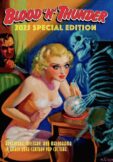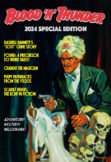EDitorial Comments
Edgar Wallace’s JACK O’ JUDGMENT
The following essay has been adapted from my introduction to Jack o’ Judgment & Captains of Souls: Two Novels by Edgar Wallace, published last year by Stark House in a handsome trade-paperback edition. I’m posting it now because I wanted to update the blog and, frankly, have no time to write something substantive as I’m hard at work on the Murania Press publications that will debut at PulpFest.
The recent boom in small-press reprints of works by obscure crime writers and pulp fictioneers has revived interest in a good many storytellers previously forgotten. And yet, strangely, the movement to date has largely ignored Edgar Wallace, an astonishingly prolific British author who was in his time emulated, and imitated, by a host of thriller writers on both sides of the Atlantic. Very little of Wallace’s prodigious output remains in print, despite the fact that for many years one of every four books sold in Britain bore his name on its cover.
Richard Horatio Edgar Wallace was born in London on April 1, 1875, the illegitimate son of British stage performers who gave him up for adoption. Taken into the family of “fish porter” George Freeman, the boy shared a cramped home with ten siblings. This modest upbringing led young master Richard to seek employment at an early age, and only upon applying for a job that required the presentation of a birth certificate did he learn the truth about his parentage.
Leaving school at the age of 12, he toiled in various positions until joining the British army at 18. Upon being discharged Wallace—by now using the surname of his birth father—wangled a job as South African correspondent for the Reuters international news agency. The young journalist learned a great deal about Africa and its people while honing his ability as a writer and breaking several important stories. He returned to England an ace reporter for the London Daily Mail, mingling effortlessly with members of upper and lower classes alike. Moreover, he developed an uncanny knack for ferreting out news under extraordinary conditions, often relying on shady characters for tips. This experience stood him in good stead when he turned to writing fiction.
In 1905 Wallace self-published his first novel, The Four Just Men, under the auspices of Tallis Press. As an inducement to potential buyers unfamiliar with his byline, he offered 500 pounds in prize money to readers who solved the mystery surrounding a supporting character’s death at the hands of the Just Men. For this purpose the book included a form that could be filled out, detached, and mailed to the Tallis Press office. The first prize was 250 pounds; the others were lesser amounts. In preparing promotional copy for the contest Wallace failed to restrict the number of entrants, and while the novel was a huge best-seller he actually lost money because a larger-than-anticipated number of applicants correctly guessed the murder method. (He actually received financial aid from the Mail, which feared his poorly conceived scheme would reflect badly on the paper.) The newly minted author paid dearly for underestimating his readers but established himself as a thriller writer to watch. In the long run his contest payout was money well invested.
Much of Wallace’s early fiction drew upon his experience in Africa. The exploits of his first series character, Sanders of the River, reflected typical Victorian-era attitudes regarding British colonialism. Commissioner Sanders maintained order among squabbling native tribes using considerable ingenuity and relying on his vast knowledge of human nature. Most readers today find Sanders condescendingly paternalistic at best and arrogantly racist at worst, but in the 20th century’s first two decades Wallace’s tales in this series were well received and collected in book form on both sides of the Atlantic.
During the First World War, Edgar Wallace wrote about such heroic AEF aviators as Tam o’ the Scoots and the Companions of the Ace-High, whose careers were documented in Everybody’s Magazine and The Popular Magazine respectively. After the War he increasingly turned to the production of crime thrillers, especially when the firm of Street & Smith purchased American rights to much of his output for one of its most successful pulps, Detective Story Magazine. By this time his yarns were appearing regularly in such British periodicals as The Strand, The Thriller, The Grand Magazine, and The Detective Magazine.
Wallace cleverly rebuffed requests for exclusivity from American pulp-magazine publishers and placed his yarns with multiple houses; during the Twenties his works were just as likely to be seen in Doubleday’s Short Stories and Munsey’s Flynn’s and Detective Fiction Weekly as in Detective Story. As his fame grew in the United States, he frequently sold to the prestigious slicks, including Collier’s, Cosmopolitan, and The Saturday Evening Post.
Wallace enjoyed particular success in the pages of Detective Story, which serialized more than two dozen of his novels and published multi-entry series of short stories featuring his most popular recurring characters, The Ringer and The Three Just Men. One of his earliest contributions to the venerable Street & Smith pulp was “Jack O’Judgment,” which ran in six weekly installments from March 9 through April 13, 1920. It was published in hard covers the next month by the British house Ward Lock and then again the following year by the Boston-headquartered firm of Small, Maynard & Company.
“Jack O’ Judgment” is a key title in Wallace’s oeuvre. A pulpy thriller through and through, it marks the first major work in which he employed a “mystery man” protagonist whose motivation remained unknown until the closing chapters. Garbed in slouch hat and cloak, his face masked, Jack mocks his adversaries with a shrill laugh, talks of himself in the third person, and leaves a jack of clubs as his calling card. He appears seemingly out of thin air and vanishes without a trace. For reasons known only to himself, this wraith-like figure has sworn vengeance on “Colonel” Dan Boundary, head of a blackmail ring responsible for the deaths—both suicides and murders—of numerous people whose darkest secrets have been used against them. The Colonel is also sought by Scotland Yard, represented in this story by young inspector Stafford King and distinguished commissioner Stanley Belcom. The inevitable love interest is furnished by Maisie White, stage actress and daughter of Boundary’s former partner.
“Jack O’ Judgment” crackles with suspense and melodrama while exhibiting its author’s strengths and weaknesses as a storyteller. Wallace often wrote (or dictated) his thrillers at white heat, and while his speedy composition imparted a breezy quality to these compulsively readable tales, it frequently produced embarrassing lapses in plot and characterization. The early chapters of “Jack,” for example, make a great to-do about incriminating documents collected and hidden by Boundary’s clerk, Olaf Hanson, who is working undercover for the police and seems destined to play an important role in the proceedings. Wallace, however, summarily dispatches Hanson in the novel’s first Detective Story installment and the vitally important papers are never again mentioned, even though the principal characters all know of their existence. Other inconsistencies abound but can’t be reported here lest I spoil your enjoyment of the story. Odds are they escaped the notice of Detective Story readers who digested the yarn in weekly portions of ten thousand words.
But therein lies the point: Edgar Wallace thrillers usually move at such a breathless pace, and are crowded with so many exciting incidents and colorful characters, that errors of continuity often go undetected. It doesn’t matter that the characters are two dimensional or that certain narrative devices are reused ad infinitum. The author is a master at drawing readers into a world of his own creation. Wallace’s London is especially magical; its familiar landmarks are carefully and realistically described—the journalist’s penchant for conveying shrewd observations in terse sentences is obvious here—but his imagination conjures up a sort of phantom city in which seedy and none-too-bright underworld denizens rub shoulders with grotesquely disguised criminal masterminds and independently wealthy Scotland Yard inspectors.
36 thoughts on “Edgar Wallace’s JACK O’ JUDGMENT”
Leave a Reply
Recent Posts
- Windy City Film Program: Day Two
- Windy City Pulp Show: Film Program
- Now Available: When Dracula Met Frankenstein
- Collectibles Section Update
- Mark Halegua (1953-2020), R.I.P.
Archives
- March 2023
- July 2021
- May 2021
- March 2020
- February 2020
- December 2019
- November 2019
- October 2019
- September 2019
- August 2019
- May 2019
- April 2019
- March 2019
- February 2019
- December 2018
- November 2018
- October 2018
- August 2018
- June 2018
- February 2018
- December 2017
- October 2017
- September 2017
- August 2017
- May 2017
- April 2017
- February 2017
- September 2016
- August 2016
- July 2016
- June 2016
- November 2015
- October 2015
- September 2015
- August 2015
- July 2015
- June 2015
- May 2015
- April 2015
- March 2015
- February 2015
- January 2015
- August 2014
- July 2014
- June 2014
- May 2014
- April 2014
- January 2014
- December 2013
- September 2013
- August 2013
- July 2013
- June 2013
- May 2013
- April 2013
- March 2013
- February 2013
- January 2013
- December 2012
- October 2012
- September 2012
- August 2012
- July 2012
- June 2012
- May 2012
Categories
- Birthday
- Blood 'n' Thunder
- Blood 'n' Thunder Presents
- Classic Pulp Reprints
- Collectibles For Sale
- Conventions
- Dime Novels
- Film Program
- Forgotten Classics of Pulp Fiction
- Movies
- Murania Press
- Pulp People
- PulpFest
- Pulps
- Reading Room
- Recently Read
- Serials
- Special Events
- Special Sale
- The Johnston McCulley Collection
- Uncategorized
- Upcoming Books
- Western Movies
- Windy City pulp convention
Dealers
Events
Publishers
Resources
- Coming Attractions
- Field Guide to Wild American Pulp Artists
- MagazineArt.Org
- Mystery*File
- ThePulp.Net






Ok, now you’ve wetted my whistel, where do I pick up a copy?